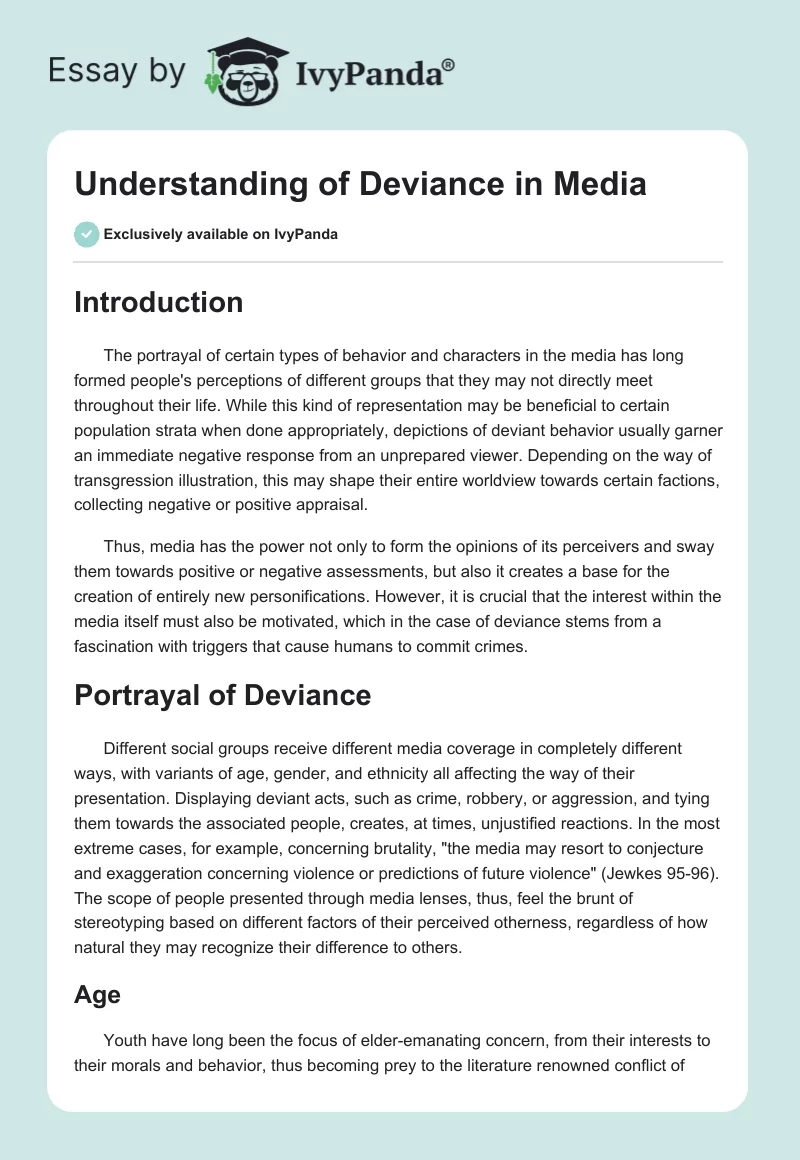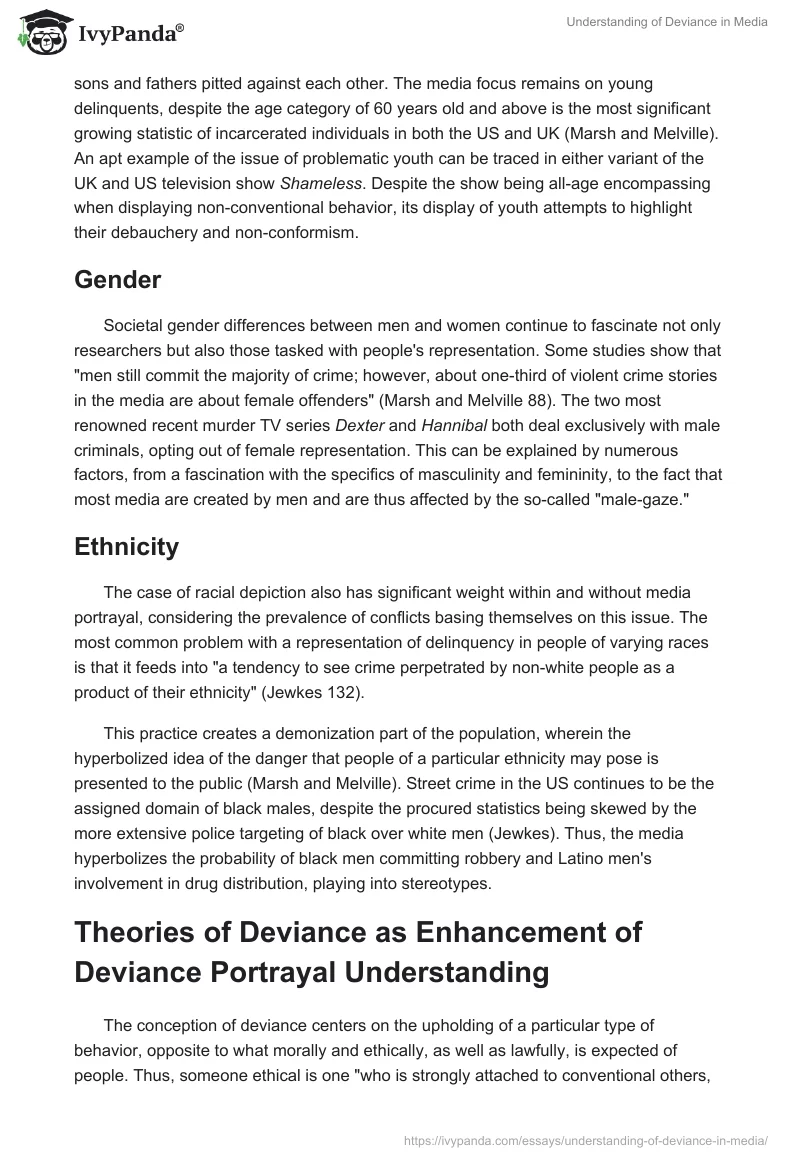Introduction
The portrayal of certain types of behavior and characters in the media has long formed people’s perceptions of different groups that they may not directly meet throughout their life. While this kind of representation may be beneficial to certain population strata when done appropriately, depictions of deviant behavior usually garner an immediate negative response from an unprepared viewer. Depending on the way of transgression illustration, this may shape their entire worldview towards certain factions, collecting negative or positive appraisal.
Thus, media has the power not only to form the opinions of its perceivers and sway them towards positive or negative assessments, but also it creates a base for the creation of entirely new personifications. However, it is crucial that the interest within the media itself must also be motivated, which in the case of deviance stems from a fascination with triggers that cause humans to commit crimes.
Portrayal of Deviance
Different social groups receive different media coverage in completely different ways, with variants of age, gender, and ethnicity all affecting the way of their presentation. Displaying deviant acts, such as crime, robbery, or aggression, and tying them towards the associated people, creates, at times, unjustified reactions. In the most extreme cases, for example, concerning brutality, “the media may resort to conjecture and exaggeration concerning violence or predictions of future violence” (Jewkes 95-96). The scope of people presented through media lenses, thus, feel the brunt of stereotyping based on different factors of their perceived otherness, regardless of how natural they may recognize their difference to others.
Age
Youth have long been the focus of elder-emanating concern, from their interests to their morals and behavior, thus becoming prey to the literature renowned conflict of sons and fathers pitted against each other. The media focus remains on young delinquents, despite the age category of 60 years old and above is the most significant growing statistic of incarcerated individuals in both the US and UK (Marsh and Melville). An apt example of the issue of problematic youth can be traced in either variant of the UK and US television show Shameless. Despite the show being all-age encompassing when displaying non-conventional behavior, its display of youth attempts to highlight their debauchery and non-conformism.
Gender
Societal gender differences between men and women continue to fascinate not only researchers but also those tasked with people’s representation. Some studies show that “men still commit the majority of crime; however, about one-third of violent crime stories in the media are about female offenders” (Marsh and Melville 88). The two most renowned recent murder TV series Dexter and Hannibal both deal exclusively with male criminals, opting out of female representation. This can be explained by numerous factors, from a fascination with the specifics of masculinity and femininity, to the fact that most media are created by men and are thus affected by the so-called “male-gaze.”
Ethnicity
The case of racial depiction also has significant weight within and without media portrayal, considering the prevalence of conflicts basing themselves on this issue. The most common problem with a representation of delinquency in people of varying races is that it feeds into “a tendency to see crime perpetrated by non-white people as a product of their ethnicity” (Jewkes 132).
This practice creates a demonization part of the population, wherein the hyperbolized idea of the danger that people of a particular ethnicity may pose is presented to the public (Marsh and Melville). Street crime in the US continues to be the assigned domain of black males, despite the procured statistics being skewed by the more extensive police targeting of black over white men (Jewkes). Thus, the media hyperbolizes the probability of black men committing robbery and Latino men’s involvement in drug distribution, playing into stereotypes.
Theories of Deviance as Enhancement of Deviance Portrayal Understanding
The conception of deviance centers on the upholding of a particular type of behavior, opposite to what morally and ethically, as well as lawfully, is expected of people. Thus, someone ethical is one “who is strongly attached to conventional others, strongly committed to conventional activities, heavily involved in them, and imbued with a strong belief in the need to obey the rules” (Downes et al. 208). Any anomaly in this behavior is perceived as aberrant and requiring appropriate punishment, at least in the form of social displeasure.
Numerous theories of deviance present their arguments, attempting to prove the origins of criminal behavior through a multitude of approaches. Any factor can become a motive for a crime, but there are three distinctly highlighted theories dealing with social disintegration, criminal delusion, and economic conflict (Downes et al.). Thus, the fascination of the media’s depiction of offenders becomes a case of not a simple desire to display offenders to sway public opinion but to show the various relationships between society and individuals.
Three shows have been highlighted for their depictions of different degrees of delinquent behavior, ranging from petty crime, to manslaughter and cannibalism: Shameless, Dexter, and Hannibal. In each of them, the lawbreakers are presented, eventually, in a positive manner, with the audience being swayed to sympathize with alcoholics, maniacs, thieves, and other various lawbreakers. Despite Shameless being all-age encompassing when displaying non-conventional behavior, its display of youth attempts to present their debauchery and non-conformism in a dual light through the creation of an empathetic narrative.
Dexter follows the killing sprees of a proclaimed psychopath, and Hannibal deals directly with one of the most appalling crimes: cannibalism. The positive portrayal of these main characters may be linked with a “cathartic factor,” which allows the audience to live a different life with different emotions using a simple TV screen (Jewkes 195). Thus, popular media cannot be tasked solely with the formation of public opinion, but also with an entertainment factor, through a depiction of unlived by the viewer lives.
Conclusion
The fascination with delinquency links to numerous factors, all of them rooted in a deep enchantment with human thought, action, and society. The use of stereotyping remains an unfortunate method within media, as well as a direct consequence of it, prevalent because of this pursuit. The motives of depicted delinquent main characters can be linked directly to the theories of human deviance, which allows for the creation of explanations regarding their portrayal.
The utility of their illustration is drawn not from a moral high ground of punishment, but from a method of communication with the audience. This, the meaning behind the creation of delinquent narratives does not pivot itself around the moralizing trope, prevalent in classical literature, but instead focuses on catharsis through presentment. The nature of numerous movies, TV series, and even songs, depicting deviance in either way, positive or negative, is the result of an eagerness for the depiction of human relationships.
Works Cited
Downes, David, et al. Understanding Deviance: A Guide to the Sociology of Crime and Rule-Breaking. 7th ed., Oxford University Press, 2016.
Jewkes, Yvonne. Media and Crime. 3rd ed., SAGE, 2015.
Marsh, Ian, and Gaynor Melville. Crime, Justice and the Media. 2nd ed., Routledge, 2014.


